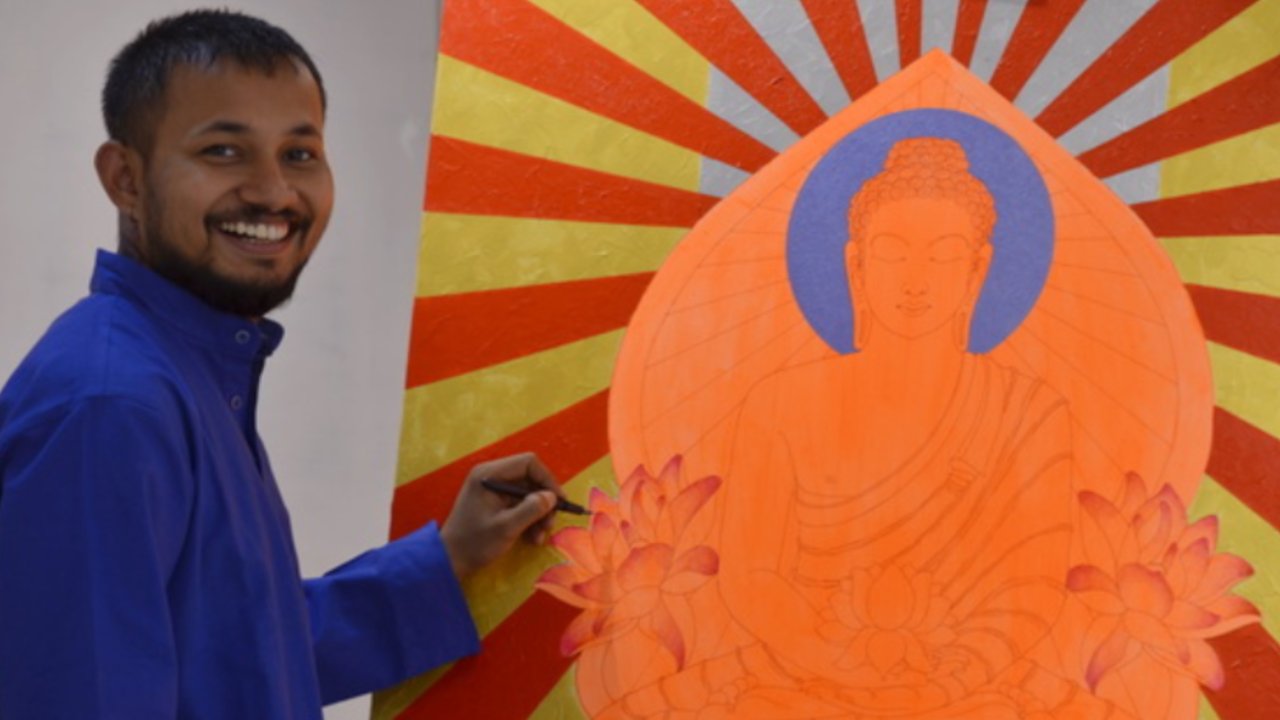Prof. Nirbhay Rana, Asst. Professor, Department of Design and Program Coordinator, Fashion at IILM University Gurugram, stands as a distinguished Pracademic with over 15 years of experience at the forefront of both the fashion industry and academia. His commitment lies in advancing sustainable fashion practices, imparting his extensive expertise to aspiring fashion professionals as a dedicated educator, shaping their perspectives and skills.
In addition to his teaching role, Prof. Rana plays a pivotal part on examination panels at Kurukshetra University and Gurugram University, ensuring rigorous educational standards and assessments. Notably, he has designed the syllabus for the Bachelor of Apparel and Fashion Designing course at Kurukshetra University.
Prof. Rana’s impactful contributions are reflected in his notable publications focusing on sustainable fashion, such as ‘Ethical AI Integration in Marketing Strategies for Sustainable E-Commerce Fashion Designing’ and ‘Green Marketing Strategies for Sustainable Fashion: Educating and Engaging Consumers’, both published by IGI Global USA.
As a distinguished Fellow of the Royal Society of Arts (RSA) in London, Prof. Rana exemplifies deep dedication to excellence and social responsibility. His research, particularly on Sustainable Fashion and Inclusivity, underscores his proactive approach to tackling contemporary challenges and driving positive transformations within the fashion industry.
In a compelling dialogue with The Interview World, Prof. Nirbhay Rana highlights the critical role of sustainable fashion in today’s industry. He emphasizes its profound impact on students’ career trajectories and delves into how the fashion sector can drive broader environmental sustainability objectives. Prof. Rana also shares fascinating insights into the innovative approaches students take in sustainable fashion design. Additionally, he underscores his department’s pivotal role in championing sustainable practices within the fashion domain. Here are the key insights gleaned from his interview.
Q: What does sustainable fashion mean to you, and why is it important in today’s industry?
A: Sustainable fashion is a game-changer in designing, producing, and consuming clothing. It champions environmental stewardship, social responsibility, and economic viability. This approach means creating fashion with a keen awareness of our planet and its resources while ensuring fair treatment and wages for those involved in production. In today’s industry, the importance of sustainable fashion cannot be overstated.
The fashion industry stands as one of the world’s major polluters, contributing significantly to water pollution, waste, and carbon emissions. Furthermore, sustainable fashion tackles this issue head-on, using eco-friendly materials, reducing waste, and promoting recycling and upcycling. Fast fashion, on the other hand, often exploits labor, underpaying workers and subjecting them to poor conditions. Moreover, sustainable fashion disrupts this narrative. It also advocates for ethical practices that ensure workers are treated fairly, paid living wages, and work in safe environments.
Consumer awareness is on the rise. People are also waking up to the impact of their purchases on the environment and society, increasingly seeking brands that align with their values of sustainability and ethics. Brands that embrace sustainable practices build trust and loyalty with their customers. Though sustainable fashion might come with higher upfront costs, it leads to long-term savings and stability. Sustainable practices also drive innovation, cut waste, and create a more resilient supply chain.
As resources dwindle and environmental regulations tighten, the need for sustainable practices will become even more critical. Brands that invest in sustainability today will be better prepared to face future challenges. Sustainable fashion strikes a perfect balance, allowing the industry to thrive without compromising the planet or the people making the products. It’s not just a trend; it’s an essential evolution towards a more equitable and sustainable future.
Q: How do you think incorporating sustainable practices in fashion education can influence students’ careers and the industry as a whole?
A: Incorporating sustainable practices in fashion education not only prepares students for successful careers but also drives meaningful industry change. This approach aligns our educational standards with the United Nations Sustainable Development Goals (SDGs). By weaving sustainability into our curriculum, we ensure that future fashion professionals meet industry demands while contributing to global goals of environmental stewardship, social equity, and economic sustainability. Our students gain the knowledge and skills needed to tackle pressing environmental and social challenges head-on.
Our sustainable fashion model includes several key components. First, we emphasize on-demand and custom-made fashion to reduce overproduction and waste, prioritizing quality over quantity. We encourage designs that focus on durability, longevity, and timeless appeal, curbing the environmental impact of fast fashion. We instill principles of fairness and ethical treatment throughout the supply chain, from sourcing materials to ensuring fair wages and safe working conditions.
Creativity is promoted through redesign and upcycling techniques, transforming waste materials into new, valuable fashion pieces. We introduce students to innovative business models like clothing rental and swapping platforms, which reduce consumption and extend the lifecycle of garments. Furthermore, we stress the value of second-hand and vintage clothing to promote sustainable consumption habits and reduce textile waste.
Lastly, we educate students on sustainable production methods, including eco-friendly fabrics, low-impact dyes, and renewable energy use, to minimize environmental footprints. By embracing this comprehensive sustainable fashion model, we empower students to become agents of positive change in the industry. They learn to create fashion responsibly and contribute to a more sustainable and ethical future for fashion worldwide.
The impact on students’ careers is profound. As sustainability takes center stage in the fashion industry, students trained in these practices acquire highly sought-after skills, making them more competitive and better prepared for roles in companies that prioritize eco-friendly and ethical practices. Sustainability education fosters creative thinking and problem-solving, teaching students to use new materials, design methods, and production techniques that minimize waste and reduce environmental impact. These skills are crucial for addressing industry challenges.
Understanding the social and environmental impacts of fashion helps students develop a strong ethical foundation, influencing their decision-making to prioritize fair labor practices and environmental stewardship in their careers. Sustainable fashion programs often involve partnerships with industry leaders and sustainable brands, offering students valuable networking opportunities, real-world experience, and potential job placements, enhancing their career prospects.
The industry itself benefits greatly from this shift. Graduates with a background in sustainability bring these values into their workplaces, influencing company policies and practices. As more professionals advocate for eco-friendly methods, the industry moves towards more sustainable practices. Educated professionals can inform and influence consumers about the benefits of sustainable fashion, shifting consumer behavior towards responsible purchasing and driving demand for sustainable products. This encourages more brands to adopt eco-friendly practices.
As resources become scarcer and environmental regulations tighten, sustainable practices will be essential for the industry’s survival. Educating future leaders in sustainability equips them to navigate these challenges, securing the long-term health of the fashion industry. Focusing on sustainability in education fosters a culture of innovation, leading to the development of new materials, technologies, and business models that can revolutionize the industry, making it more resilient and adaptable to future changes.
Q: How can fashion education contribute to broader environmental sustainability goals?
A: Environmental sustainability goals are the cornerstone of our commitment to future generations, aiming to slash carbon emissions, conserve precious water and land, minimize waste, and safeguard biodiversity. These imperatives are pivotal in our battle against climate change and in securing a robust environmental foundation.
Fashion education plays a pivotal role in this mission:
Educating students on sustainable materials, production techniques, and design principles galvanizes the adoption of eco-friendly practices. This includes harnessing organic fibers, recycled materials, and streamlined manufacturing processes to slash our environmental footprint.
Instilling circular economy principles empowers students to craft products that are rugged, repairable, and recyclable—crucial steps in slashing waste, prolonging product lifecycles, and propelling sustainable consumption and production targets forward.
Collaboration between fashion institutions, industry titans, and research powerhouses fuels innovation in sustainable tech and business models. Together, we forge new materials, eco-efficient processes, and groundbreaking solutions that push the envelope on environmental sustainability.
Fashion education molds professionals who champion transparent supply chains, ethical sourcing, and consumer enlightenment on sustainable choices. These champions are reshaping industry norms and consumer habits toward a more sustainable ethos.
Graduates aren’t just professionals—they’re advocates, navigating policy landscapes to champion regulations that incentivize sustainability, enforce environmental benchmarks, and promote industry-wide transparency.
This comprehensive strategy ensures a resilient and sustainable future for the fashion sector, aligning us with global environmental sustainability goals.
Q: In your opinion, what role do consumers play in driving demand for sustainable fashion, and how does this influence the curriculum?
A: As both an educator and consumer, I firmly believe consumers wield immense power in driving sustainable fashion forward. When we consciously support brands prioritizing ethical sourcing and environmental responsibility, we’re not just making purchases but shaping the future of the industry.
Understanding consumer behavior is crucial. Today, people are increasingly focused not just on style and price but also on the origins and practices behind their garments. This awareness significantly impacts what and how we teach in fashion education.
From my experience, integrating sustainability into the curriculum isn’t a passing trend—it’s essential for preparing students to meet market demands. By teaching about sustainable materials, ethical production, and transparent supply chains, we empower future fashion professionals to advocate for products aligned with informed consumer values.
Educators must bridge the gap between consumer expectations and industry practices. We teach students that sustainable fashion isn’t a fad but a necessary evolution toward a responsible and resilient industry. This approach not only equips them for successful careers but also ensures they contribute positively to global sustainability initiatives.
Ultimately, consumer demand for sustainable fashion isn’t just about sales figures; it’s about catalyzing meaningful change in how we produce and consume fashion. This movement paves the way towards a more sustainable future for everyone involved.

Q: What advice would you give to aspiring fashion designers who want to integrate sustainability into their work?
A: Integrating sustainability into your role as a fashion designer isn’t just about chasing trends—it’s about driving significant change in the industry and beyond. To succeed in this transformative journey, consider these essential steps:
First, educate yourself thoroughly on fashion’s environmental and social impacts. This knowledge will empower you to make informed choices about materials, production methods, and design processes. Second, prioritize timeless design that emphasizes quality craftsmanship and durability, reducing the demand for frequent replacements.
Third, select sustainable materials like organic fabrics, recycled materials, and eco-friendly alternatives to minimize environmental and societal impact. Additionally, embrace waste-reduction practices throughout your design and production processes, such as efficient pattern cutting. Transparency is crucial—be forthright about your supply chain and uphold rigorous ethical standards in production.
Avoid the trap of greenwashing by staying true to genuine sustainability efforts without embellishing claims. Collaborate with ethical suppliers, manufacturers, and fellow designers to champion sustainable practices and advocate for widespread industry reform.
By embedding these principles into your design ethos, you not only resonate with today’s discerning consumers but also drive positive change towards a more sustainable future for fashion. Remember, each deliberate decision you make as a designer holds the power to shape a brighter tomorrow.
Q: What are some innovative approaches or technologies that students are exploring in sustainable fashion design?
A: Today’s students are pioneering bold, innovative approaches in sustainable fashion design, fundamentally reshaping the industry. They harness biofabrication, using living organisms like bacteria or algae to craft eco-friendly textiles. Additionally, 3D Printing enables intricate designs with minimal waste, fostering customization and curbing overproduction. Upcycling and Circular Design transform waste materials into chic new garments, embodying sustainability principles. Smart Textiles seamlessly integrate sensors for environmental monitoring and enhanced functionality, optimizing energy efficiency.
Zero-Waste Pattern Cutting maximizes fabric usage efficiency, minimizing waste production. Natural Dyes pioneer plant-based alternatives to mitigate environmental impact in textile dyeing. Blockchain ensures unequivocal transparency in sourcing and sustainability claims. Furthermore, VR/AR technologies revolutionize design visualization, reducing dependency on physical prototypes. Sustainable Supply Chain Innovations also champion ethical sourcing and local production, slashing transportation emissions.
Collaborative Platforms also foster shared resources, promoting a circular economy in fashion. These initiatives underscore fashion education’s pivotal role in driving sustainability and technological advancement. Moreover, as an educator, I champion these strides as crucial in aligning fashion with environmental stewardship. They equip students to lead the charge toward a sustainable, socially responsible fashion industry, securing a brighter future for our planet.
Q: How does your department collaborate with industry partners to promote sustainable practices and innovation?
A: At IILM University, our Fashion Department actively promotes sustainable practices and drives innovation through strategic partnerships with industry leaders. Partnering with RESPUN, a prominent textile recycling facility in Panipat, exemplifies our commitment. Moreover, recycling bins installed in our fashion lab facilitate collection of fabric waste, which RESPUN transforms into new yarns, advancing our circular fashion initiative. We also owe immense gratitude to Vice Chancellor Prof. (Dr.) Padmakali Banerjee for her unwavering support in realizing this initiative.
Furthermore, we prioritize collaboration with artisans and craftspeople through workshops that revive traditional Indian crafts. These efforts not only preserve cultural heritage but also enrich modern fashion education.
In addition, our Center for Sustainability and Environment plays a crucial role in promoting the UN Sustainable Development Goals (SDGs). Expert lectures and workshops on sustainable dyes and eco-printing techniques empower students with practical knowledge aligned with global sustainability objectives.
Looking ahead, we are committed to expanding our sustainable fashion initiatives. Future plans include integrating circular fashion principles into our curriculum, fostering collaborative research, and launching pioneering initiatives that benefit both industry and environment.
Through these initiatives, the Fashion Department at IILM University also cultivates future fashion leaders who embody creativity, innovation, and a profound commitment to ethical and sustainable practices.
Q: What are your hopes and goals for the future of sustainable fashion education at IILM University?
A: At IILM University, our vision for sustainable fashion education is grounded in our steadfast commitment to catalyzing profound transformations within the industry and the environment. We aspire to set a precedent and inspire the next wave of fashion leaders—individuals who are not only creative and innovative but also deeply dedicated to ethical and sustainable practices.
Looking forward, we envision an evolving and expansive future for sustainable fashion education at IILM University. Nevertheless, our department is fully committed to embedding sustainability throughout our curriculum, encompassing design principles, production techniques, and consumer engagement. Moreover, we aim is to imbue students with a comprehensive understanding of environmental stewardship, social responsibility, and ethical integrity.
Guided by our university motto, “Learn with Purpose, Lead with Purpose,” the Fashion Department embraces our “Design with Purpose” approach. This approach underscores the importance of conscientious design that considers its societal and planetary impacts. By nurturing creativity alongside a profound sense of responsibility, we also prepare our students to tackle complex global challenges through innovative and sustainable solutions.
We forge partnerships with industry leaders, sustainability experts, and community stakeholders to remain at the forefront of sustainable fashion education. Through collaborative endeavors, research initiatives, and hands-on learning opportunities, we also empower our students to drive positive transformations in the fashion industry. Ultimately, our objective is to cultivate a new breed of fashion professionals—individuals who not only excel in their craft but also champion sustainability. Moreover, equipped with the requisite knowledge, skills, and values to shape a more sustainable future, our graduates leave a significant and enduring mark on the global fashion landscape.










2 Comments
Nice
Hi my friend! I want to say that this article is amazing, nice written and include approximately all important infos. I would like to see more posts like this.
Comments are closed.